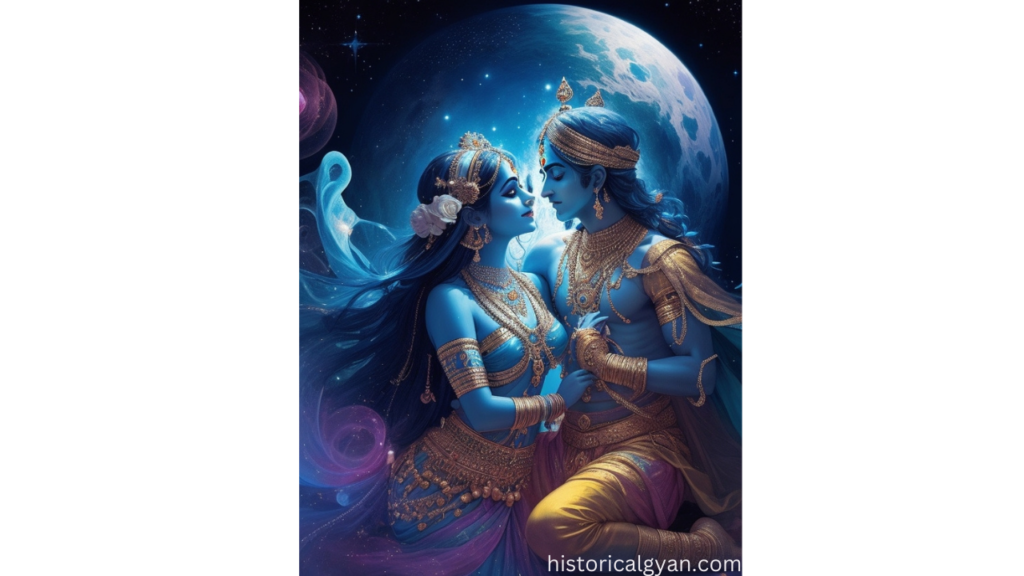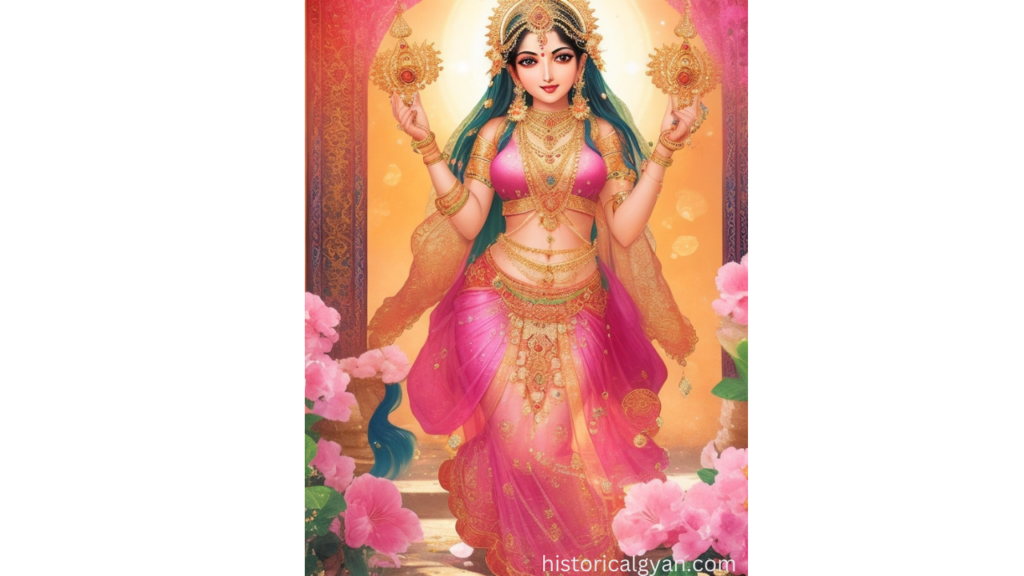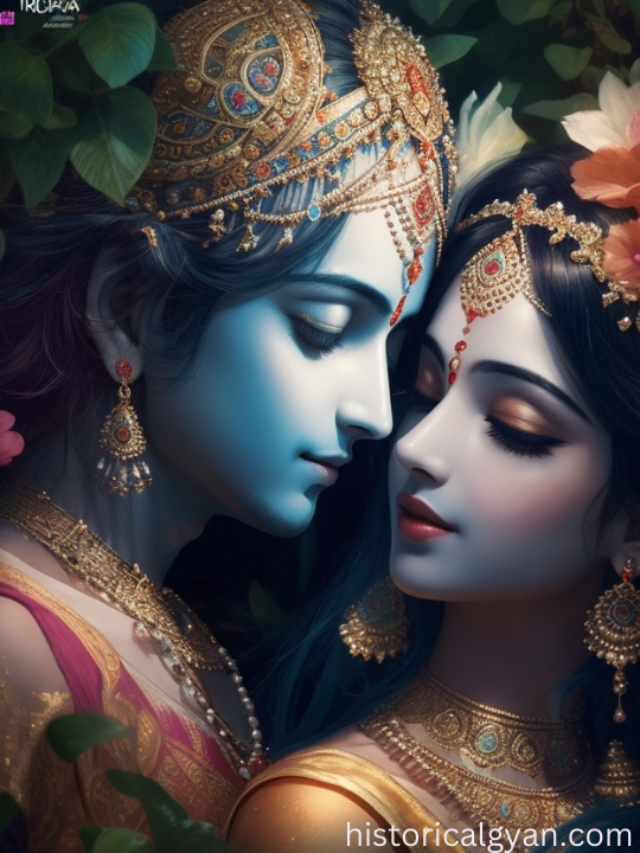Radha Krishna Relationship
In the realm of Hindu philosophy and spirituality, the divine relationship between Radha and Krishna stands as a profound and intricate subject of contemplation. This sacred bond transcends the limitations of human understanding, inviting seekers to delve into its enigmatic depths. In this comprehensive article, we embark on a journey to unravel the significance of this Radha Krishna Relationship, exploring its nuances and shedding light on the truths that lie beyond common misconceptions.

Introduction
The Divine connection between Radha and Krishna holds a central place in Hindu philosophy, symbolizing the union of the Supreme Divine and its creative energy. This profound relationship has captured the hearts and minds of devotees for centuries, inspiring awe, love, and devotion. As we delve into the intricate layers of this bond, we uncover the timeless wisdom that underscores their union.
Radha and Krishna relationship explained
Before delving into the intricacies of their divine connection, it’s crucial to address the common questions and misconceptions surrounding their relationship. Contrary to the notion of an extramarital affair, the bond between Radha and Krishna transcends human concepts of marriage. Their connection is a sacred and eternal one, rooted in the divine realm rather than subject to human norms.
Beyond Human Concepts of Marriage
In comprehending Radha and Krishna’s relationship, it’s imperative to recognize that God’s actions are not confined by human norms. The divine realm operates beyond the constraints of human understanding, and concepts like marriage do not apply to the transcendental realm. God’s actions are motivated solely by a selfless desire to guide and uplift souls, unfettered by mortal desires.

Divine Love Beyond Human Notions
The love shared between Radha and Krishna defies human limitations and desires. It is a love that transcends the physical realm and delves into the realm of the soul. Unlike human romantic relationships that are often driven by ego and self-interest, their love is selfless and pure. Krishna’s stealing of butter from the gopis exemplifies the divine playfulness that characterizes their bond, where every action is motivated by the welfare of humanity.
Radha: The Spiritual Depth
Radha occupies a unique and elevated position in Krishna’s life. Often referred to as Yoga Maya, she embodies the divine energy that propels the cosmic play. Her role transcends the mundane, serving as a beacon of spiritual wisdom and love. Radha’s connection with Krishna goes beyond the physical; it’s a spiritual bond that exemplifies the intertwining of the divine and the human.
The Energetic and the Energy
Radha and Krishna’s relationship is best understood as the interaction between the energetic (Krishna) and the energy (Radha). This dynamic interplay symbolizes the dance between the creator and the created, the source and its manifestation. Radha’s devotion and love act as a conduit, channeling Krishna’s divine energy into the realm of human experience.
Yoga Maya and its significance in Hinduism

Yoga Maya, often described as God’s personal power, plays a pivotal role in manifesting avatars and divine abodes. This divine energy enables God to interact with the material world while remaining beyond its limitations. By wielding Yoga Maya, God orchestrates the grand cosmic drama, guiding souls on their evolutionary journey.
The Many Forms of Energy
The divine energy, represented by goddesses such as Durga, Sita, Lakshmi, and Kali, manifests in various forms to facilitate different aspects of creation. These forms illuminate the multifaceted nature of the divine energy, each contributing to the tapestry of existence. Radha’s form as Yoga Maya reflects her unique role in Krishna’s divine play.
The Loving Form of Radha
Drawing parallels between human and divine relationships, Radha’s loving form resonates deeply with devotees. Just as a mother’s nurturing love captivates a child’s heart, Radha’s compassionate and affectionate nature draws devotees closer to the divine. Her role as the bestower of grace and blessings exemplifies the motherly aspect of divinity, underscoring the importance of love and compassion in spiritual progress.

The Importance of Divine Motherhood
The grace of the Divine mother holds immense importance in the path of devotion. Radha’s divine motherhood represents the nurturing and compassionate aspect of the Divine. Devotees seek her blessings, recognizing that her grace paves the way for a deeper connection with the Divine, fostering spiritual growth and transformation.
Seeking Radha’s Grace in Bhakti
In the realm of bhakti, Radha’s grace holds immense significance. Devotees seek her blessings to establish a profound connection with Krishna. Radha’s compassion and generosity are considered instrumental in nurturing the seeds of devotion within the heart. By invoking her presence, devotees aim to transcend ego-driven motivations and embrace selfless love, paving the way for a deeper connection with the divine.

Oneness of Radha and Krishna
The fundamental truth underlying Radha and Krishna’s relationship is their intrinsic oneness. They represent distinct aspects of the same Divine entity, embodying the interconnectedness of all existence. To truly understand their bond, one must recognize that Radha and Krishna are inseparable, two facets of the divine gem that together illuminate the path of devotion. The various manifestations of Yoga Maya reflect the oneness of divine energy.
The Unity of Radha and Krishna
Central to understanding Radha and Krishna’s relationship is recognizing their inseparability. They are not two separate entities but rather two aspects of the same divine reality. The misconception of viewing one as superior or inferior to the other diminishes the depth of their connection. It is essential to perceive them as a united force, each complementing the other in the cosmic dance of love and devotion.
Worshiping Radha and Krishna together
Worshiping Radha and Krishna is a practice that transcends religious boundaries. Devotees express their love and devotion through various forms of worship, including chanting, singing, and meditation. The melodious chant of “Radhe Radhe” serves as a gateway to invoke their divine presence and immerse oneself in the ocean of devotion. By understanding their oneness, devotees can channel their devotion towards a unified vision of divine love.
Conclusion
The relationship between Radha and Krishna unveils a tapestry of profound spiritual truths. This divine bond transcends human comprehension, inviting seekers to explore the depths of devotion, love, and interconnectedness. As we journey through the realms of philosophy and spirituality, we discover that Radha and Krishna’s relationship is not merely a historical tale but a timeless reflection of the eternal connection between the Divine and its manifestations.
Frequently Asked Questions
Was Radha married to Krishna?| Why didn’t Krishna marry Radha?
Radha and Krishna’s relationship transcends conventional human marriages. They share a unique spiritual and divine connection, often referred to as a sacred bond of love.
Is the relationship between Radha and Krishna considered an extramarital affair?
No, their relationship is not seen as an extramarital affair. In the spiritual context, Radha symbolizes the devoted soul’s deep connection with the divine, reflecting profound love and devotion.
Can divine beings like Krishna have relationships like humans?
Divine beings like Krishna exist beyond the limitations of human experiences. Their relationships are of a different nature, rooted in spiritual dimensions rather than human emotions.
Why is Radha often associated with devotion and love?| Why was Radha special to Krishna?
Radha represents the epitome of devotion and unconditional love for Krishna. Her spiritual love serves as an example for seekers to cultivate deep devotion and connect with the divine.
What is the significance of chanting “Radhe Radhe” in spiritual practice?
Chanting “Radhe Radhe” invokes the energy of Radha and Krishna’s love. It helps devotees channel their devotion and attune themselves to the spiritual realm.
How does the concept of simultaneous oneness and distinction apply to other divine forms?
The concept of simultaneous oneness and distinction can apply to various divine forms, emphasizing the interconnectedness of all beings with the divine source while recognizing their unique attributes.
Why is the motherly aspect of divinity important in spirituality?
The motherly aspect of divinity, represented by Radha, embodies compassion, nurturing, and grace. It helps seekers connect with the divine through a maternal bond of love and protection.
Can humans truly comprehend the nature of divine relationships?
Divine relationships are beyond human comprehension due to their spiritual and transcendent nature. They serve as inspiration for seekers to cultivate higher forms of love and devotion.
How can one seek Radha’s grace in their spiritual journey?
Seekers can connect with Radha’s grace through devotion, sincere prayers, and a genuine yearning to deepen their spiritual connection. Radha’s divine love can guide them on their path.
What are the lessons humans can learn from Radha and Krishna’s relationship?
Radha and Krishna’s relationship teaches lessons of selfless love, devotion, and the pursuit of a deeper spiritual connection. Their bond reflects the eternal dance of love between the soul and the divine.
Conclusion
In exploring the relationship between Radha and Krishna, we uncover profound insights into the realms of divine love and spirituality. Their connection exemplifies the boundless and selfless nature of devotion, inviting us to cultivate a deeper understanding of our own spiritual journeys. As we reflect on their timeless bond, may we find inspiration to embrace love and devotion in our lives, fostering a deeper connection with the divine.

